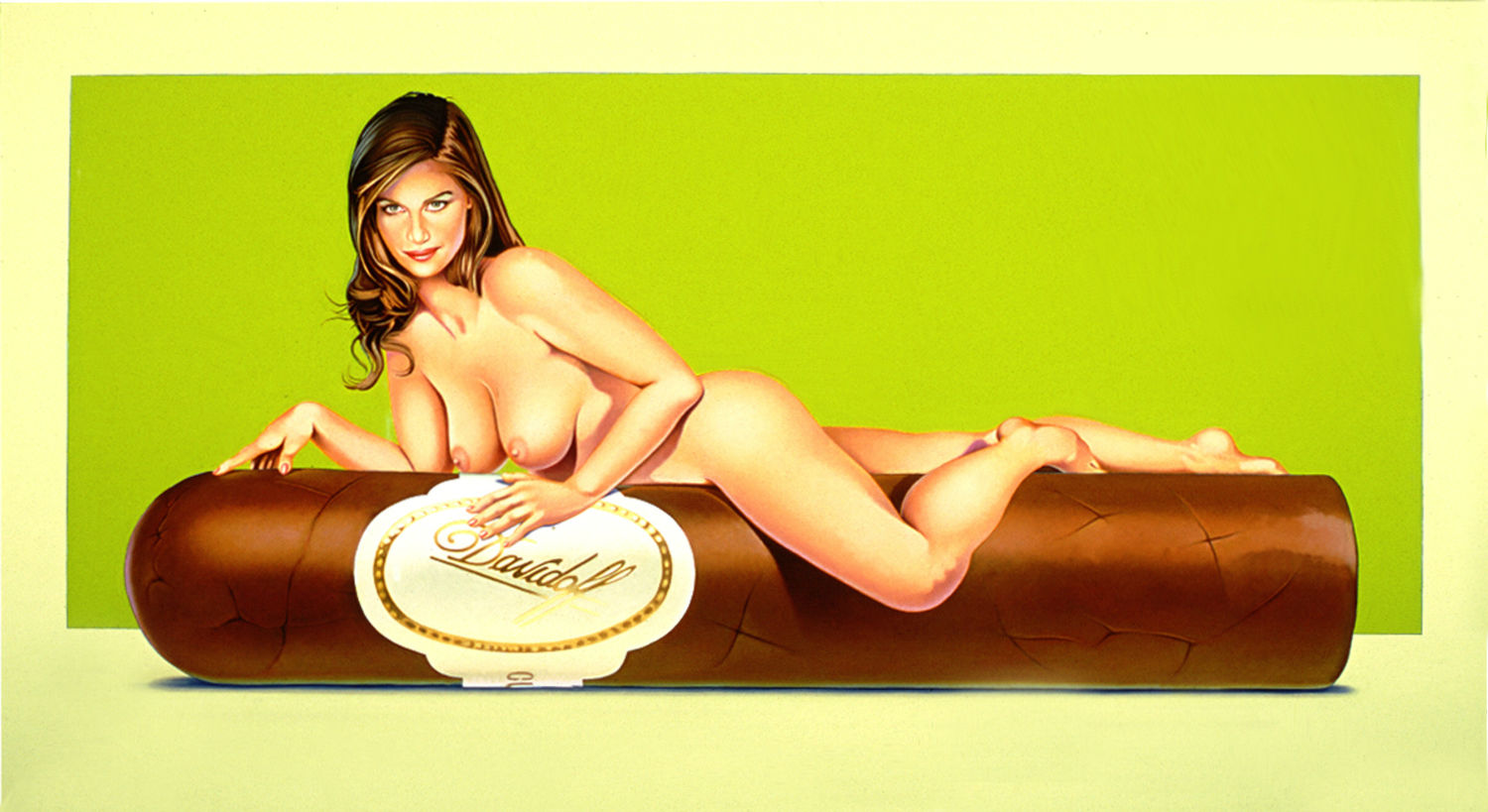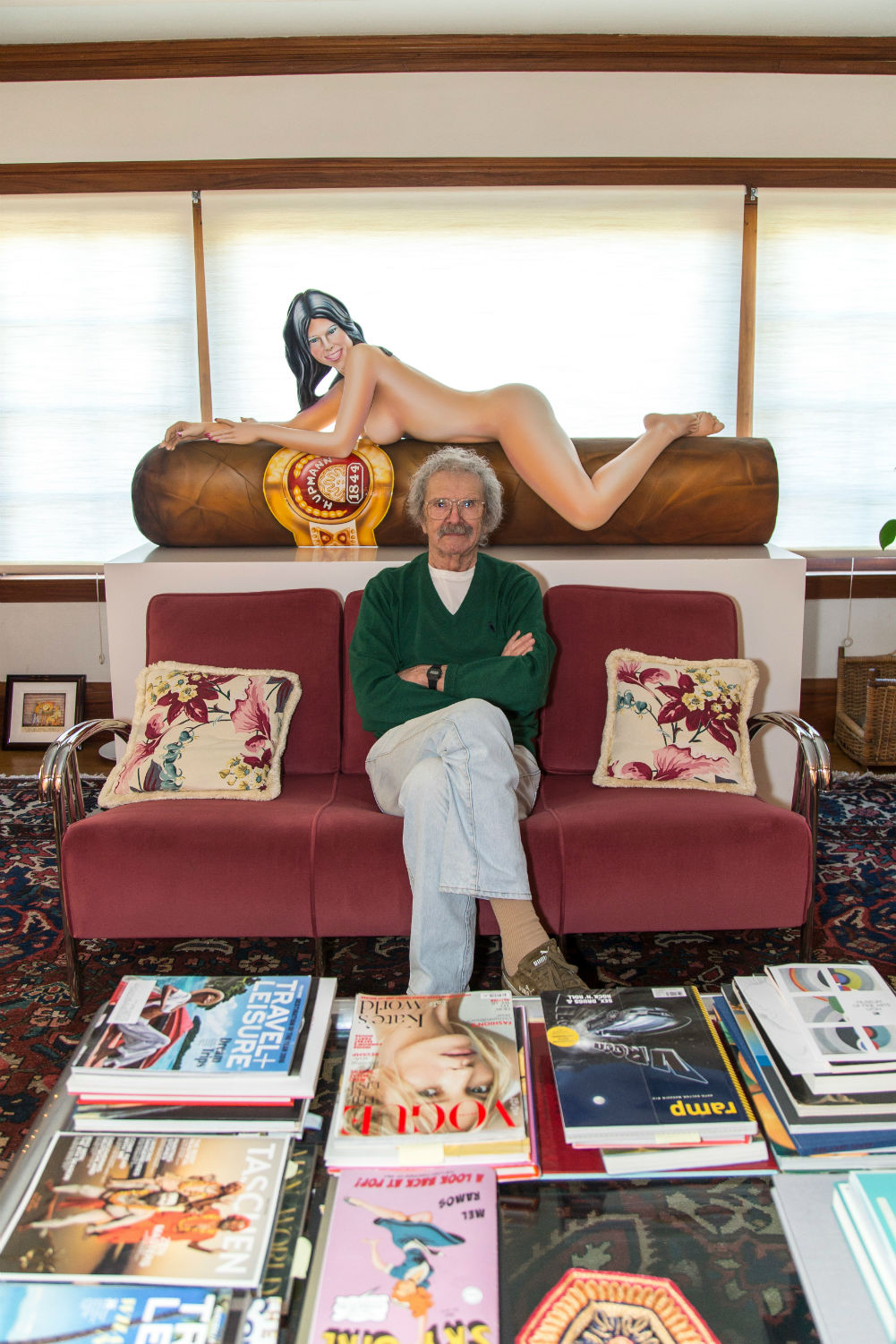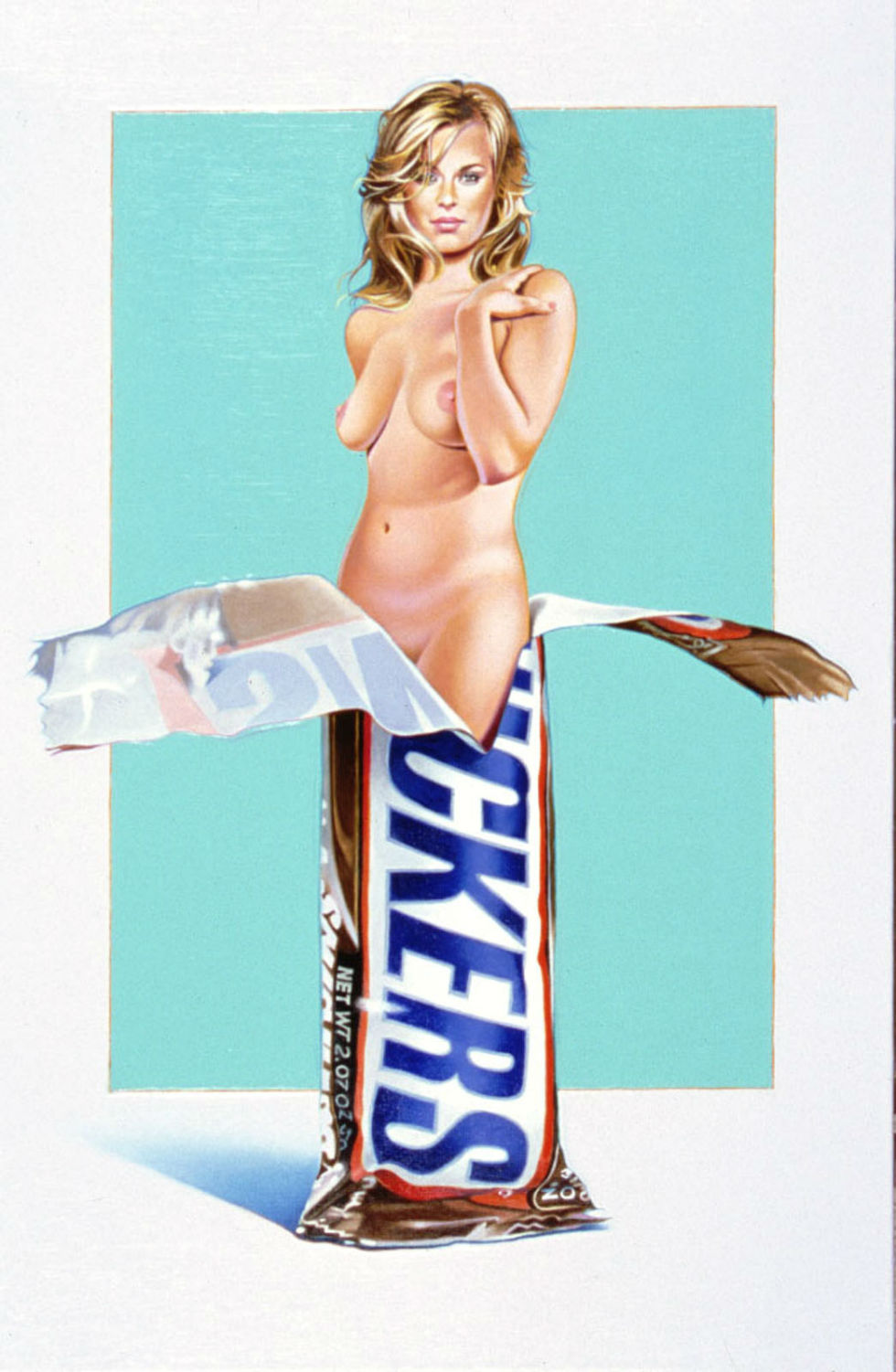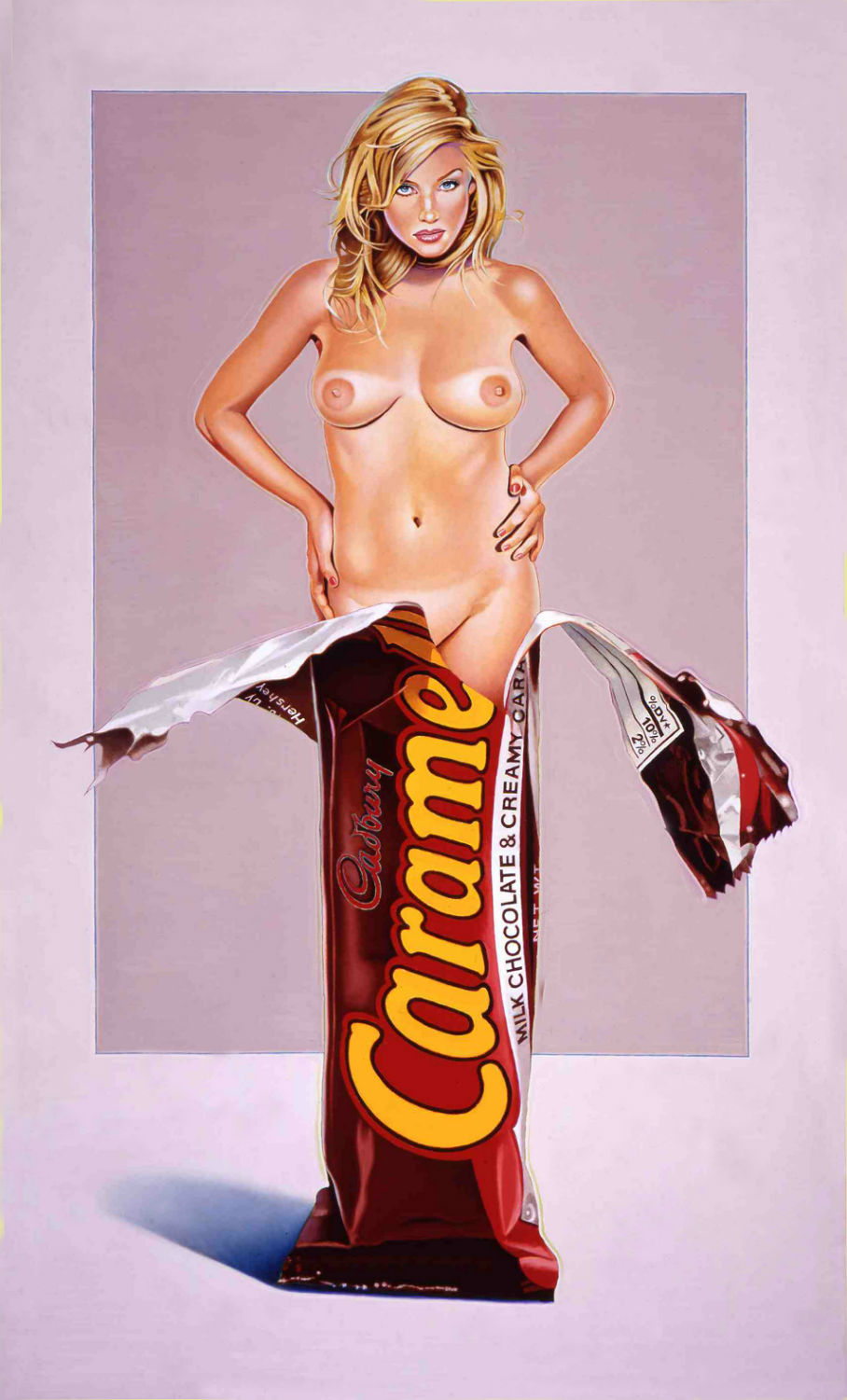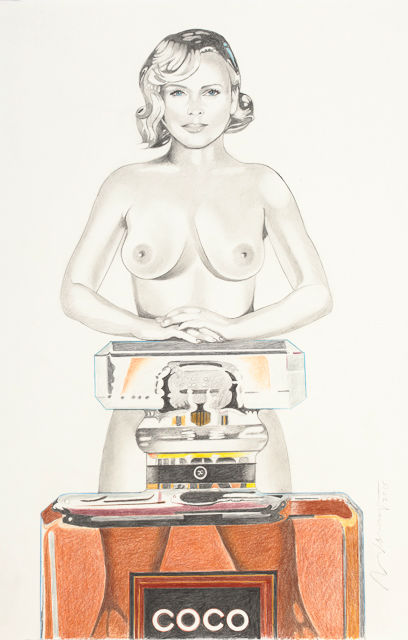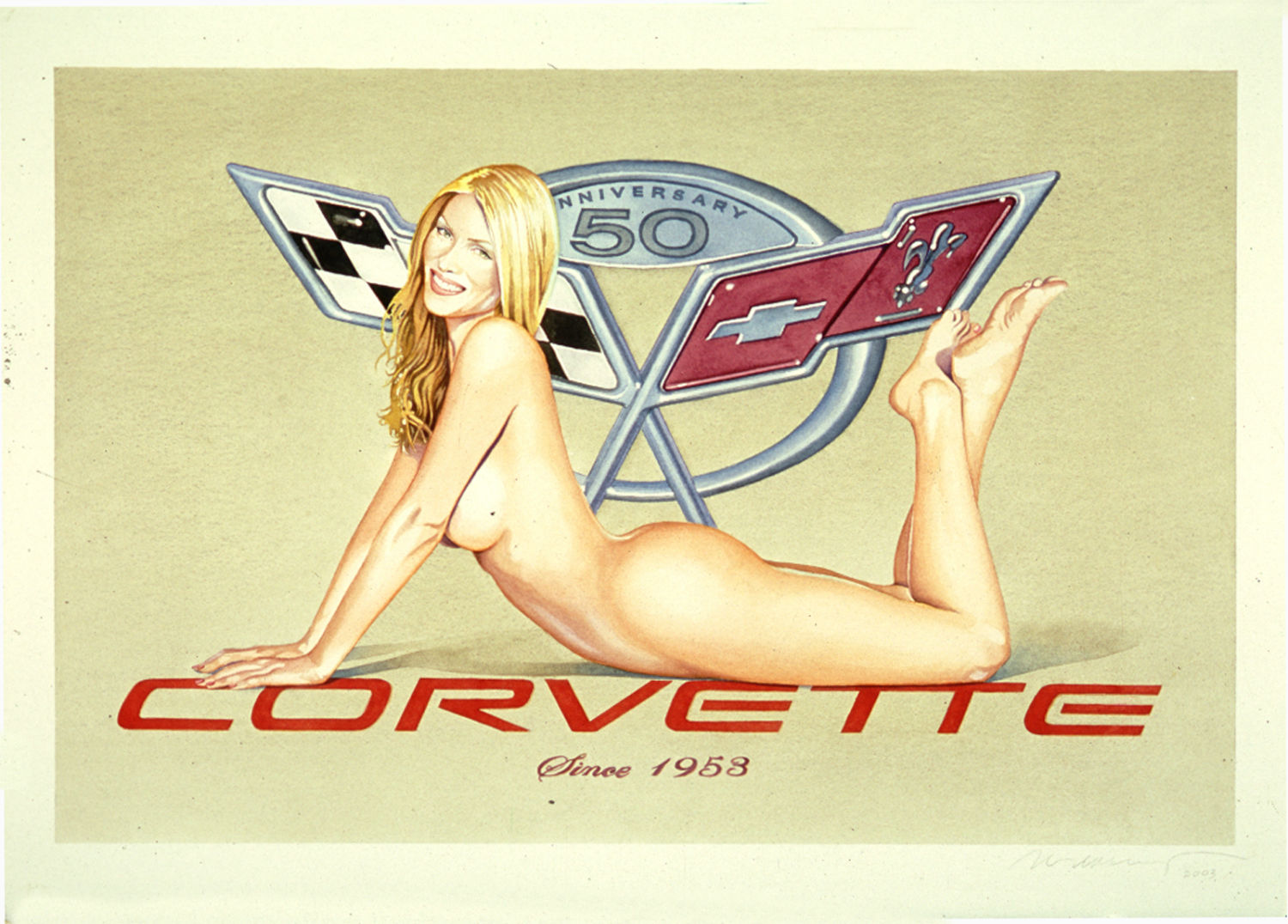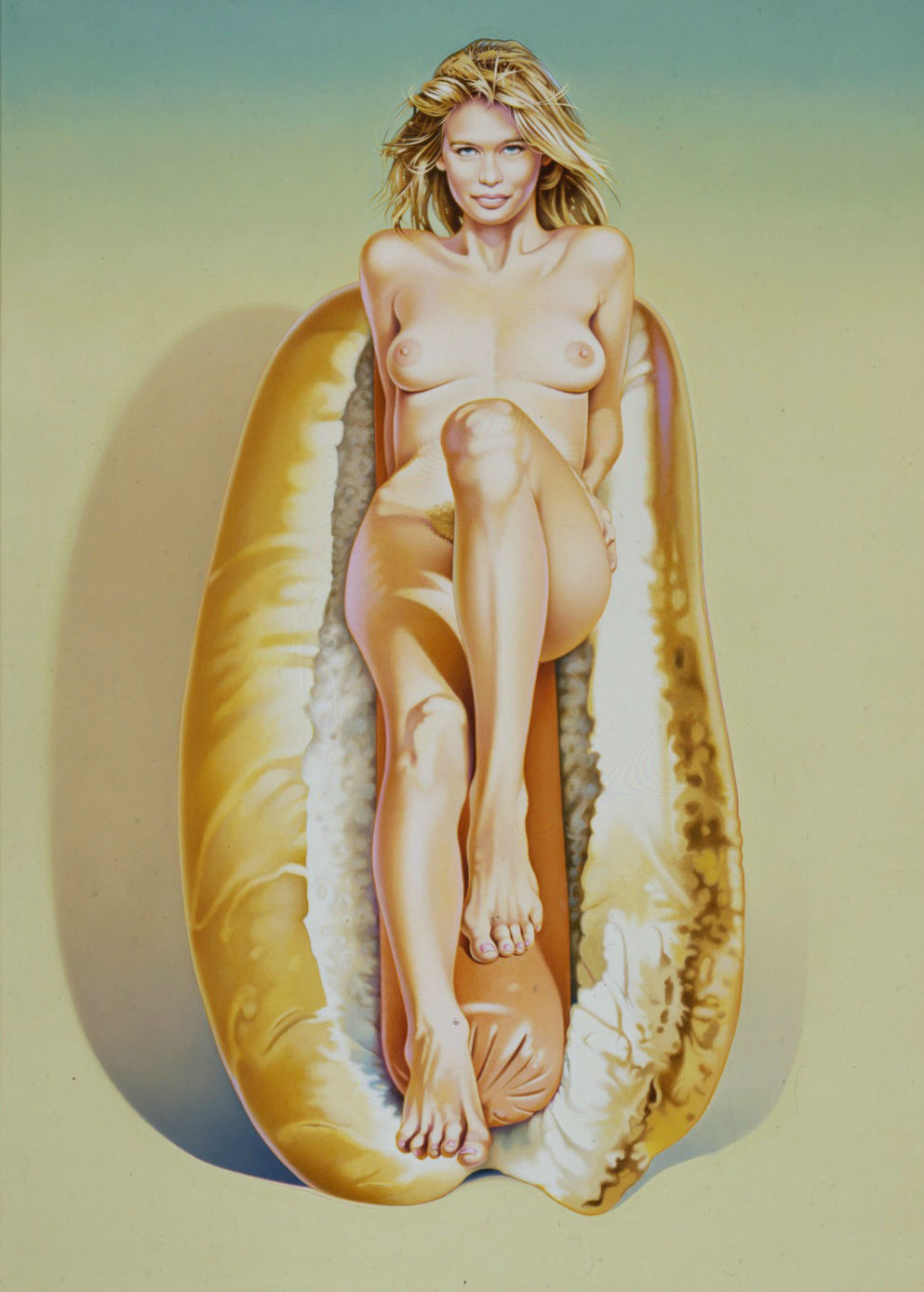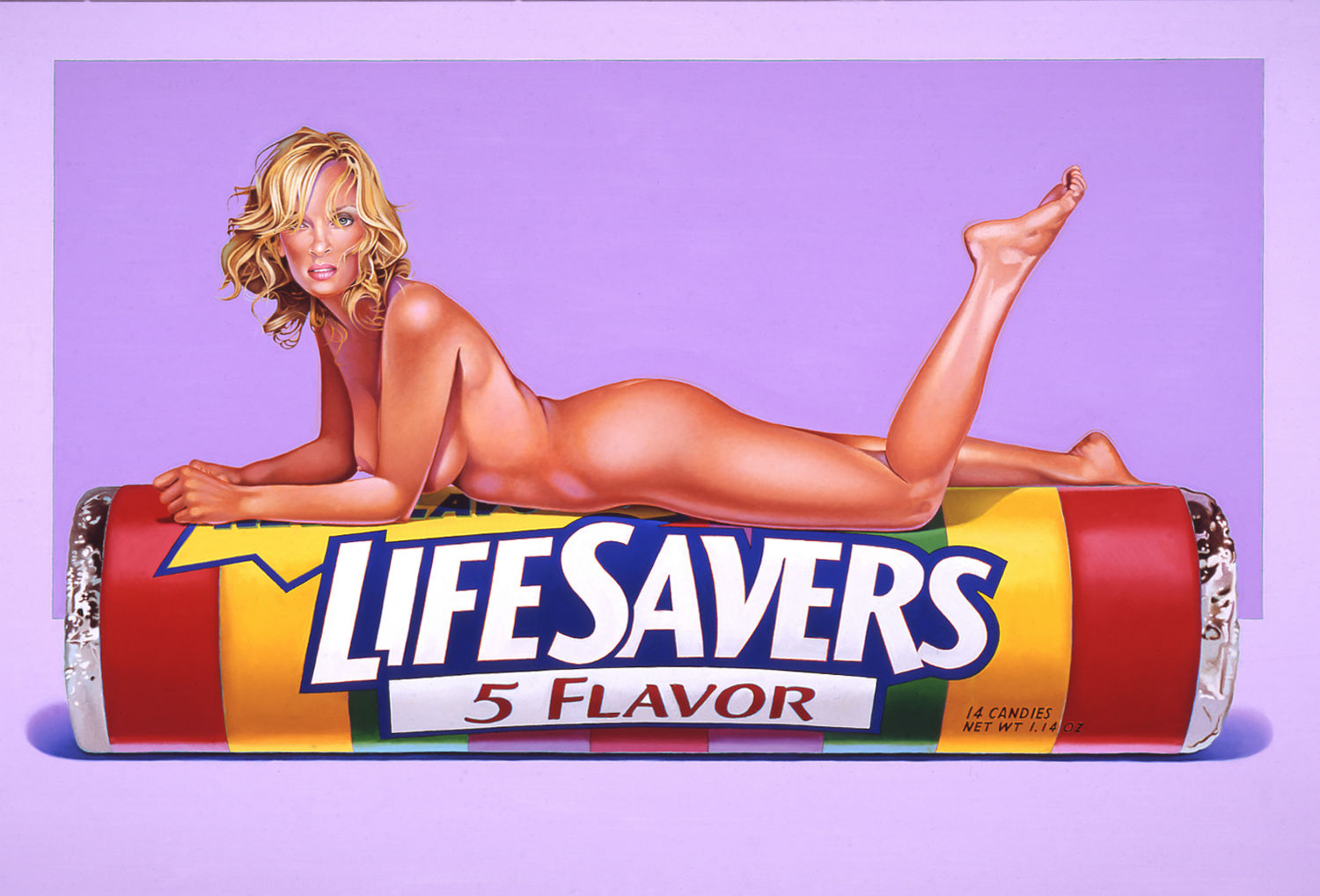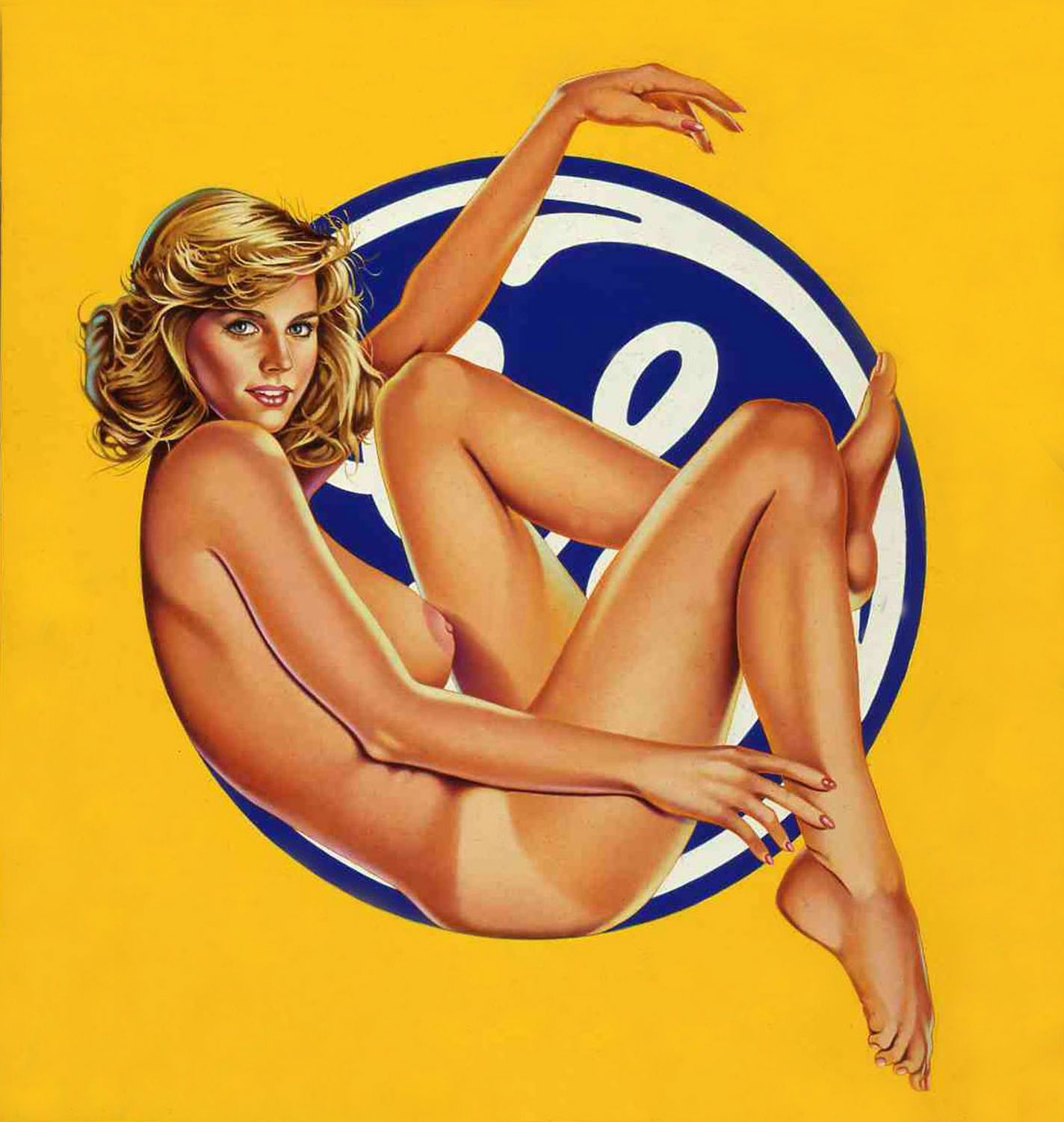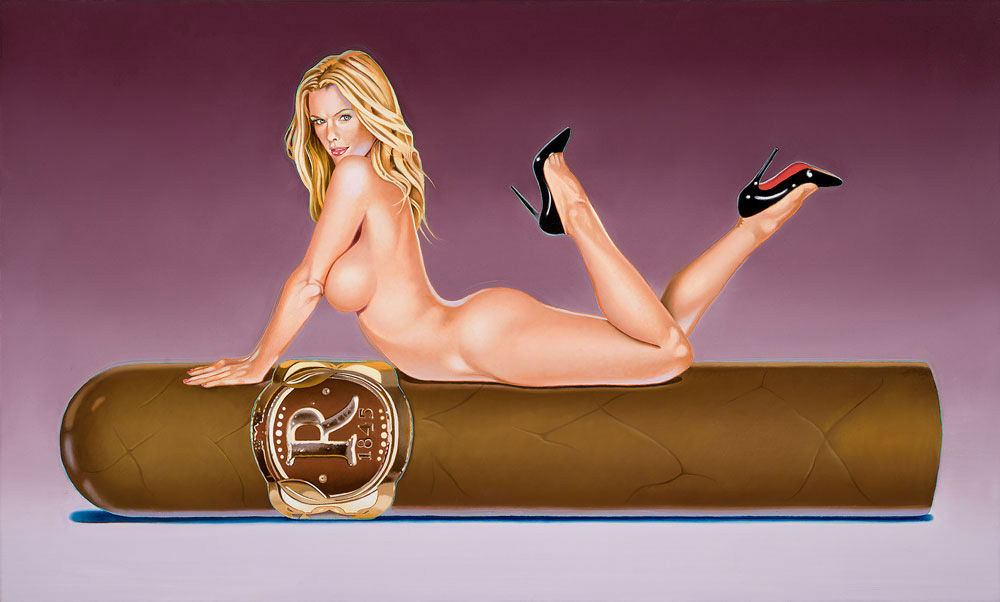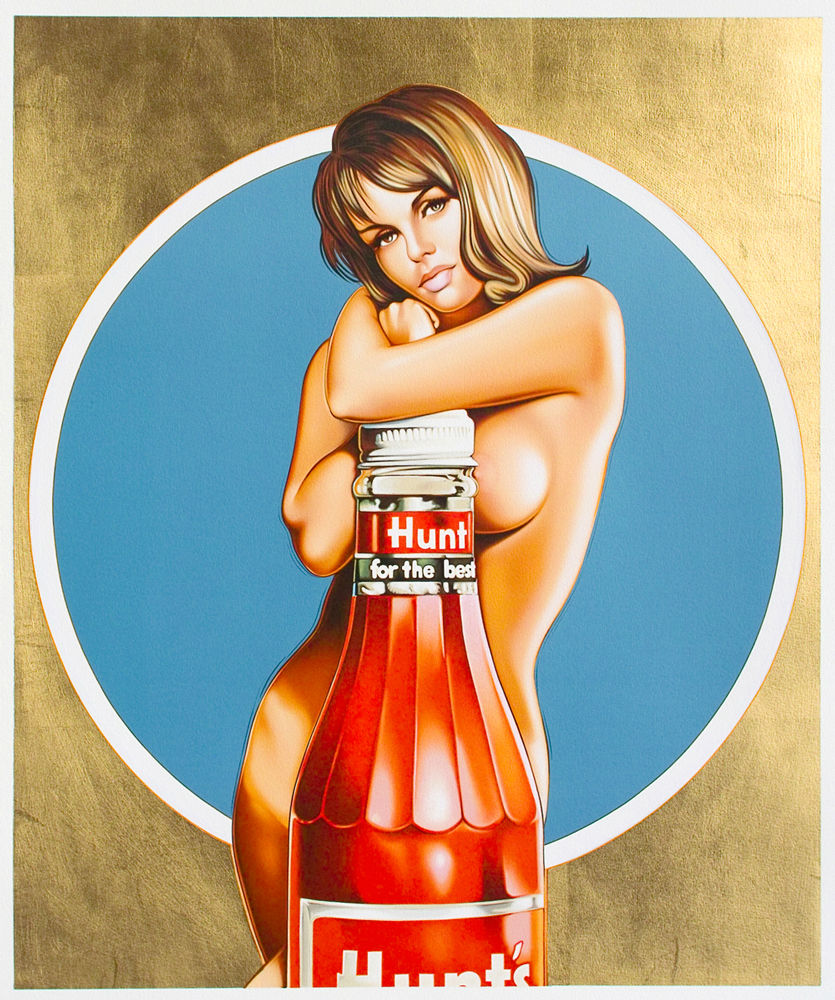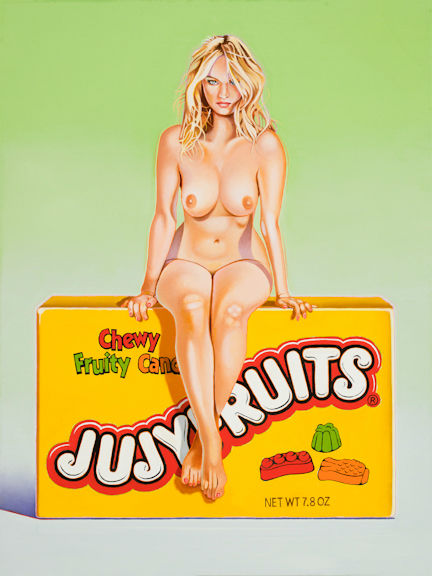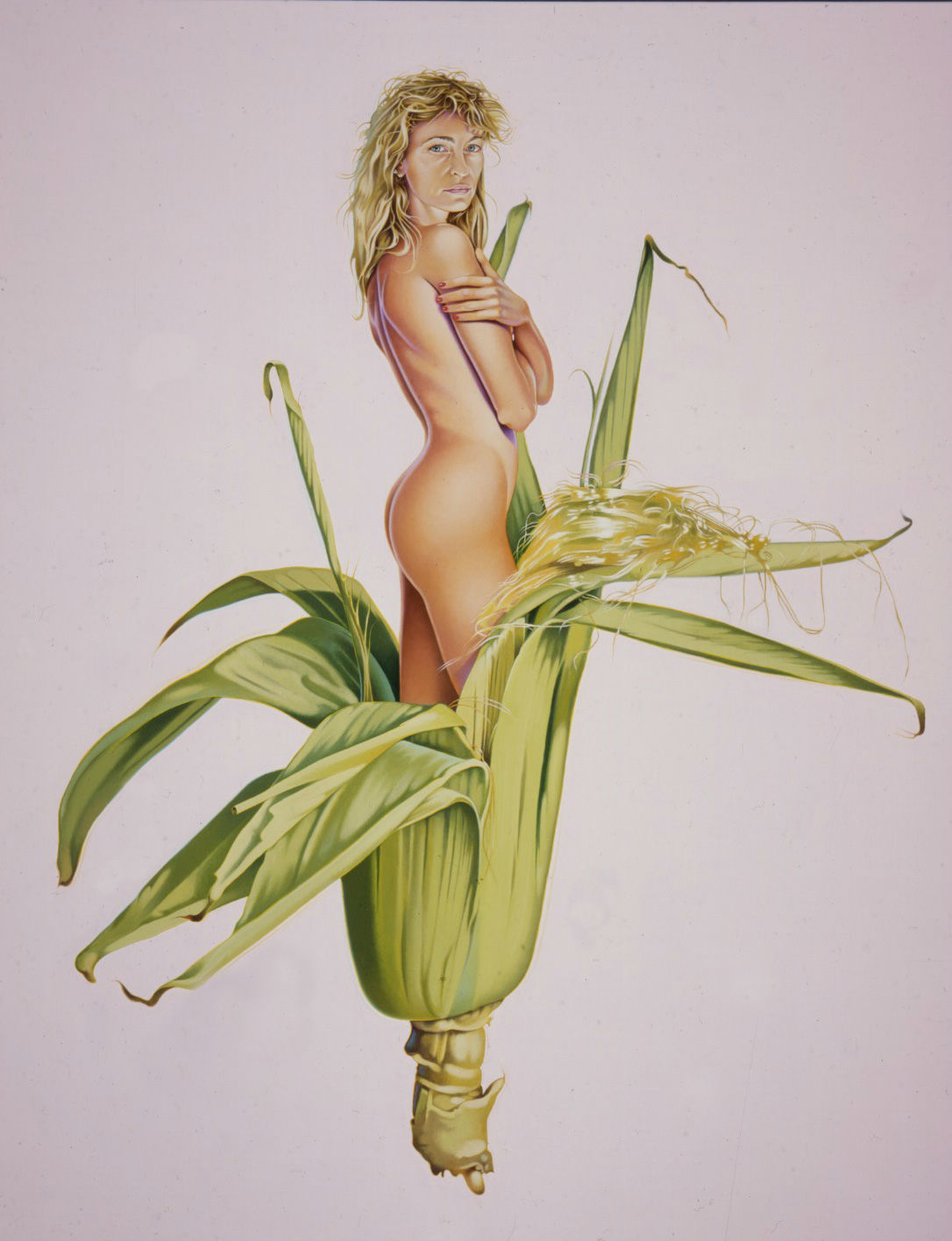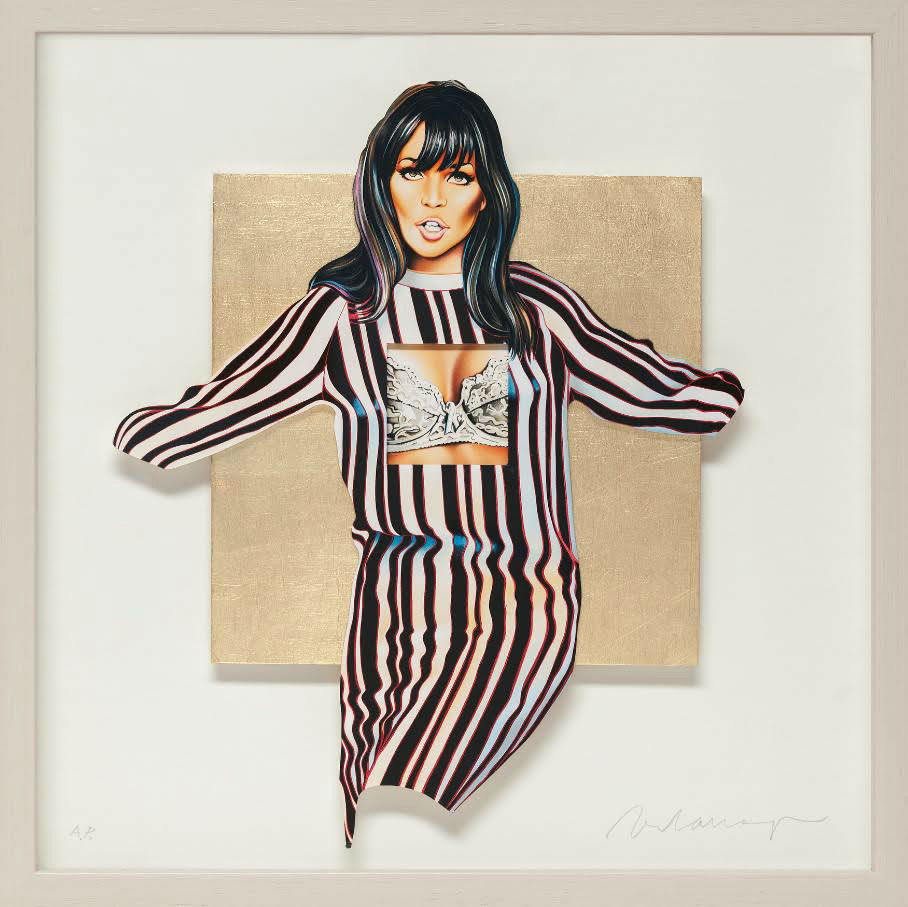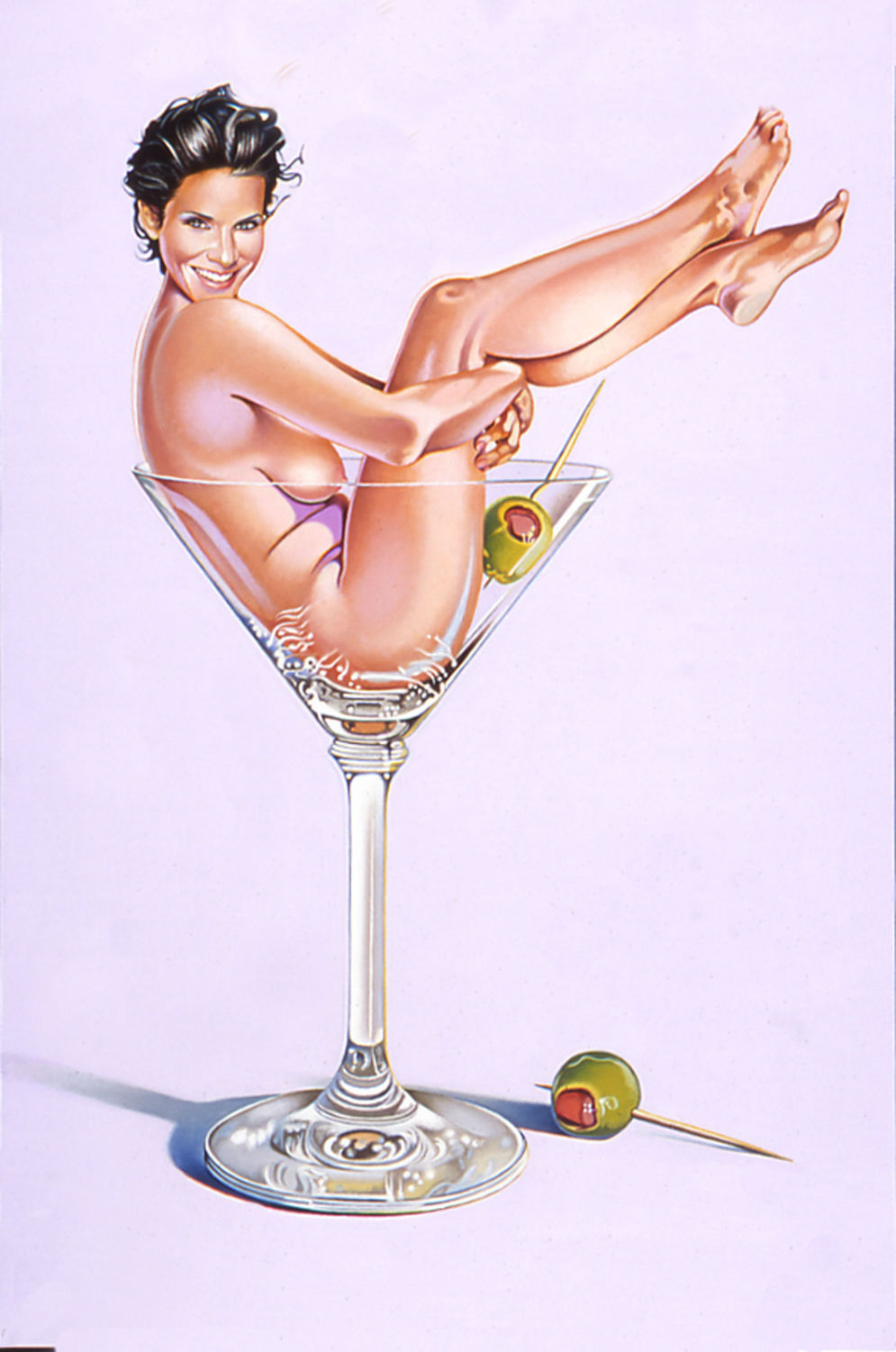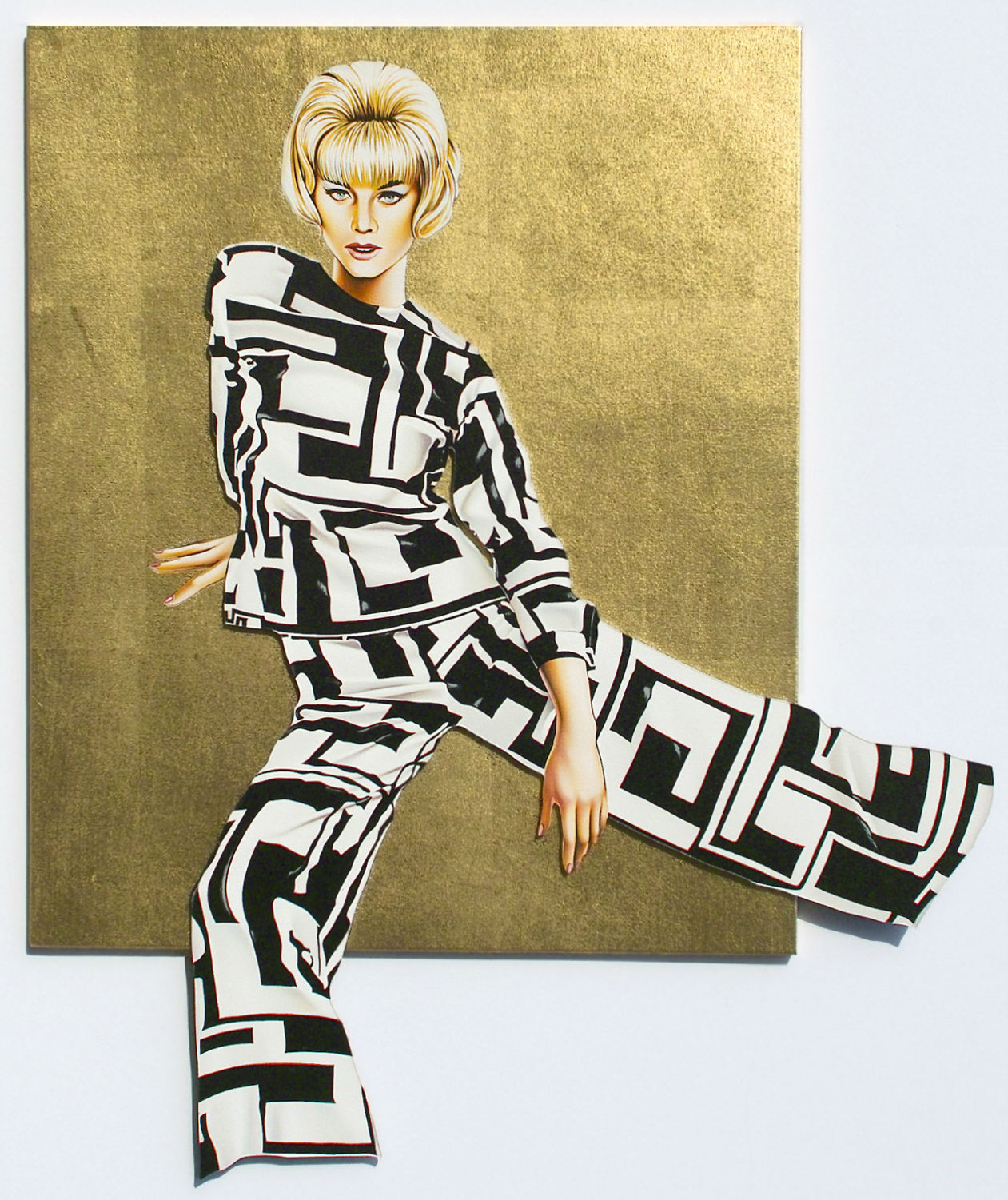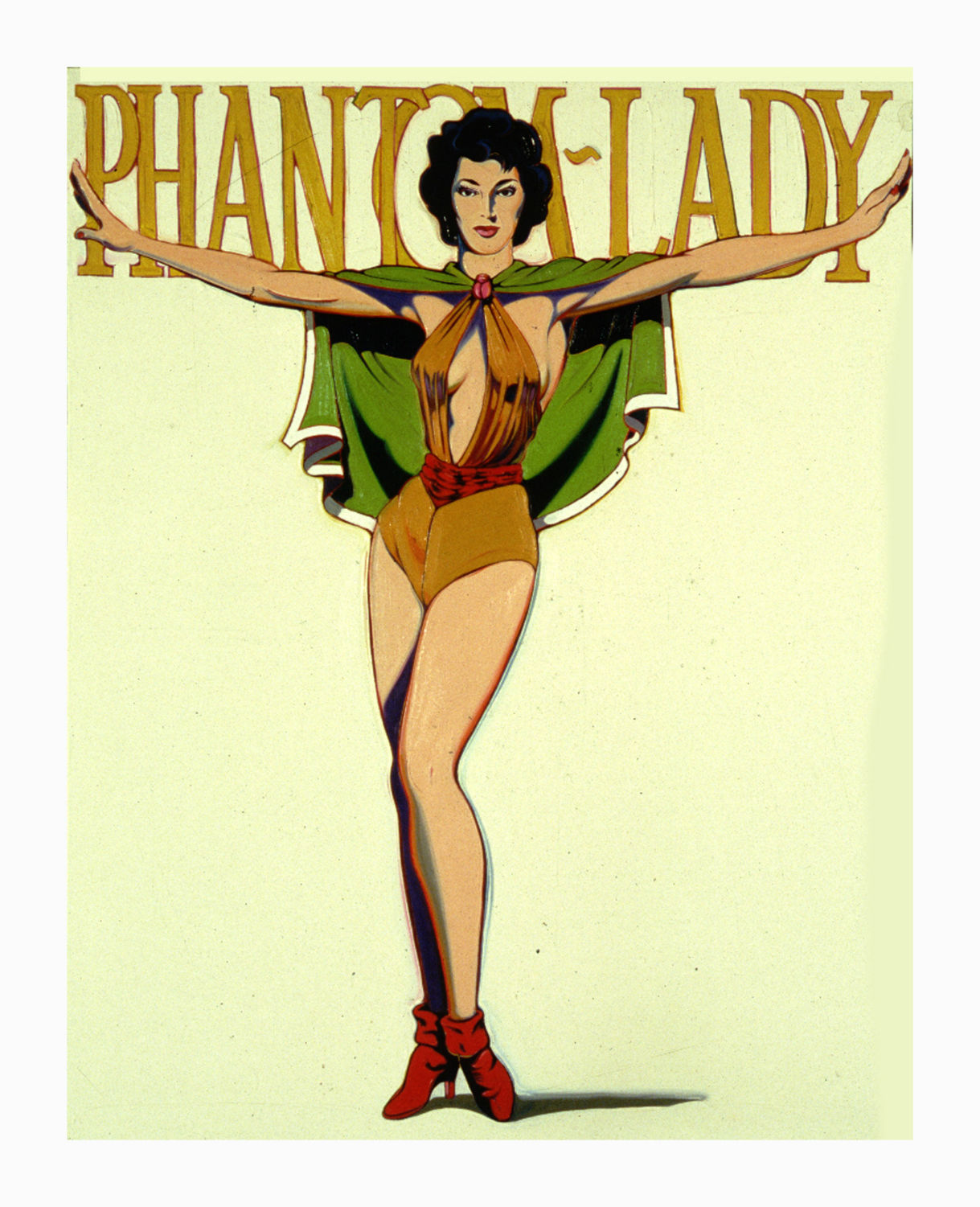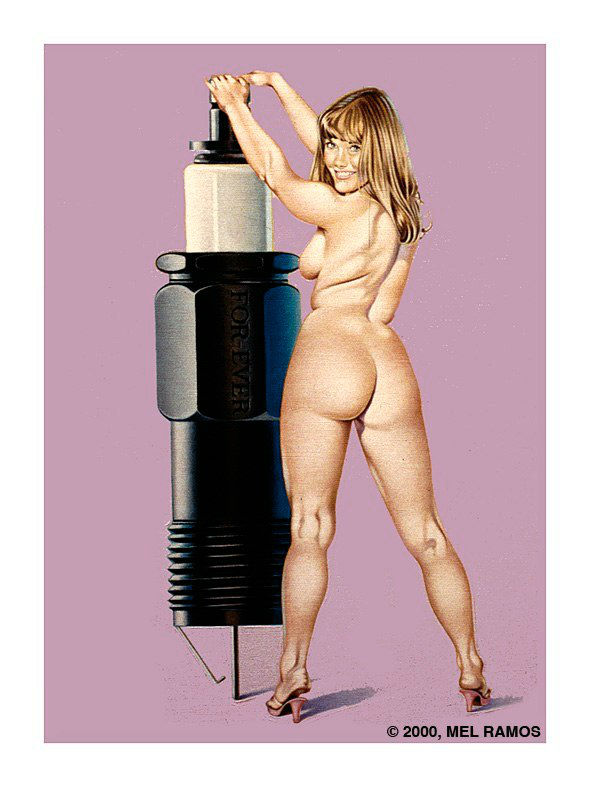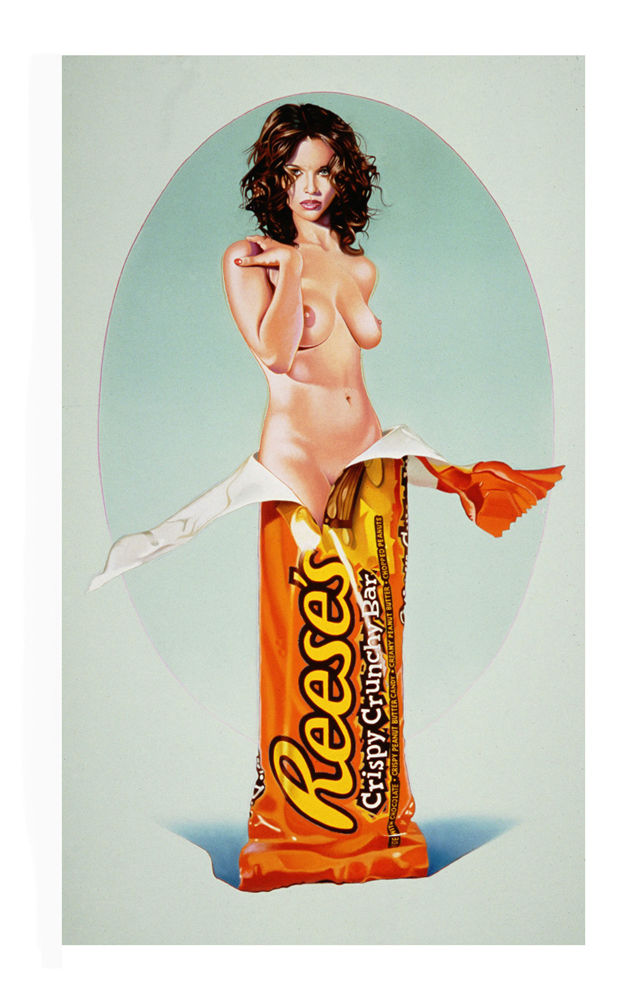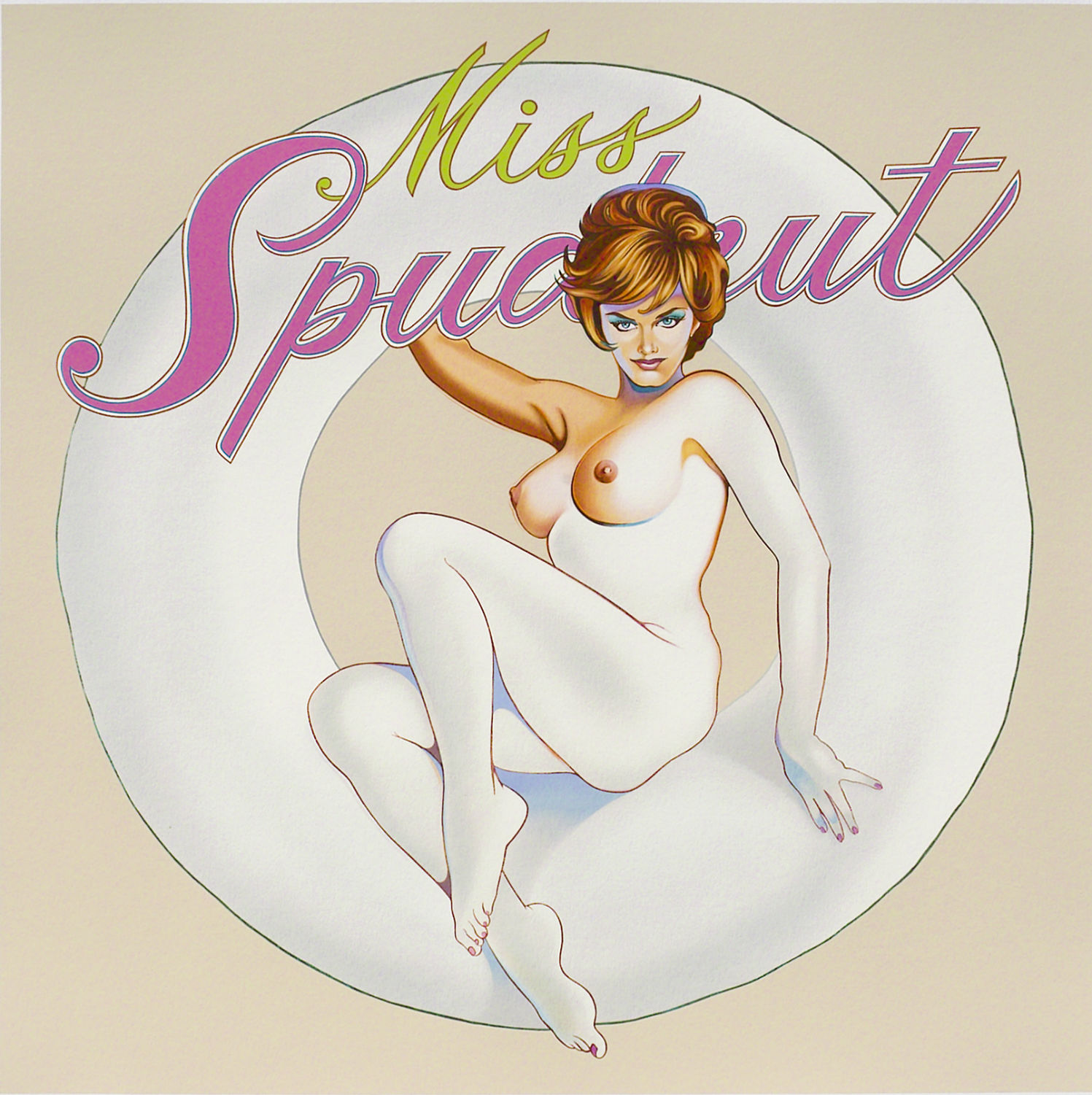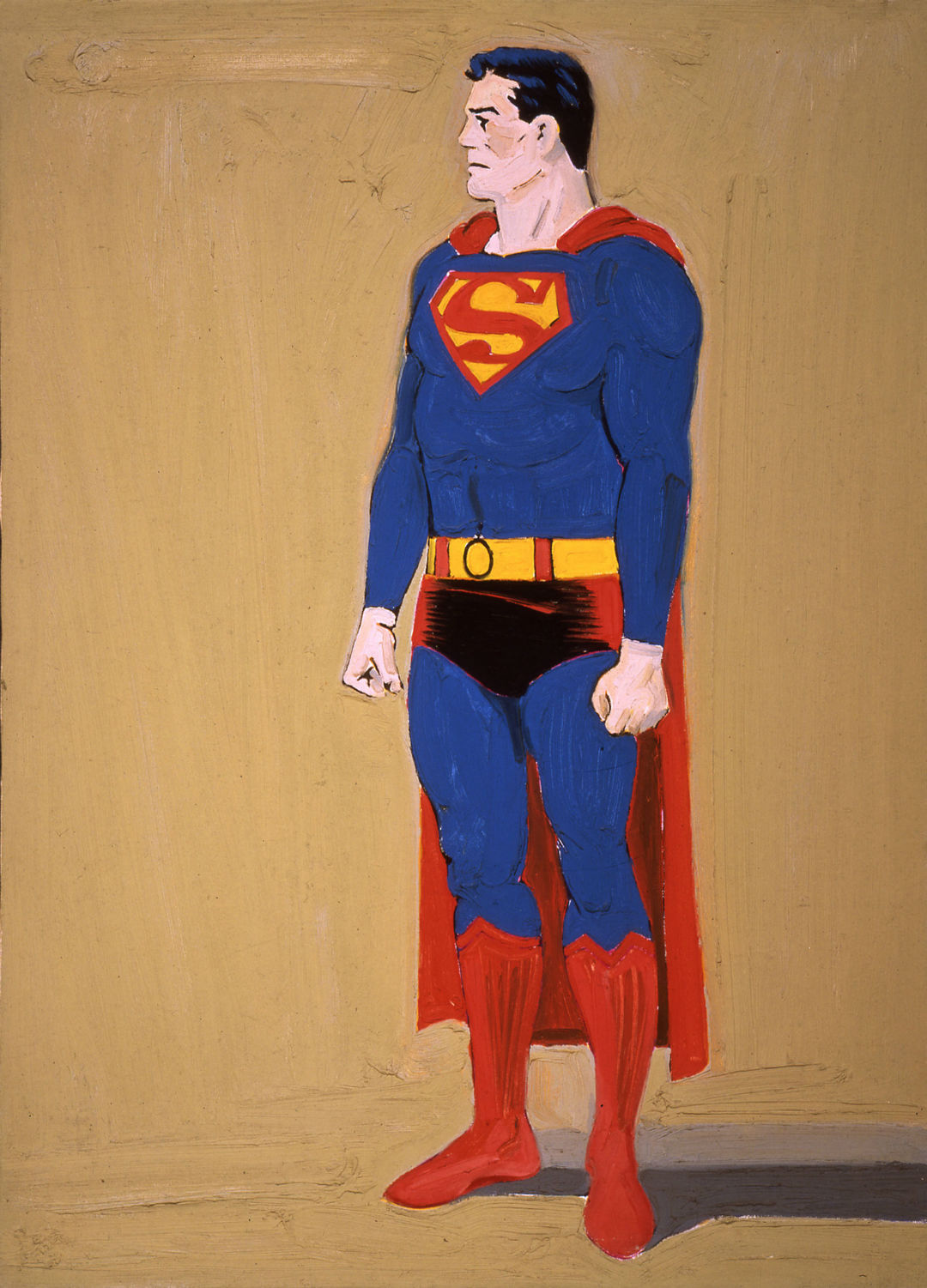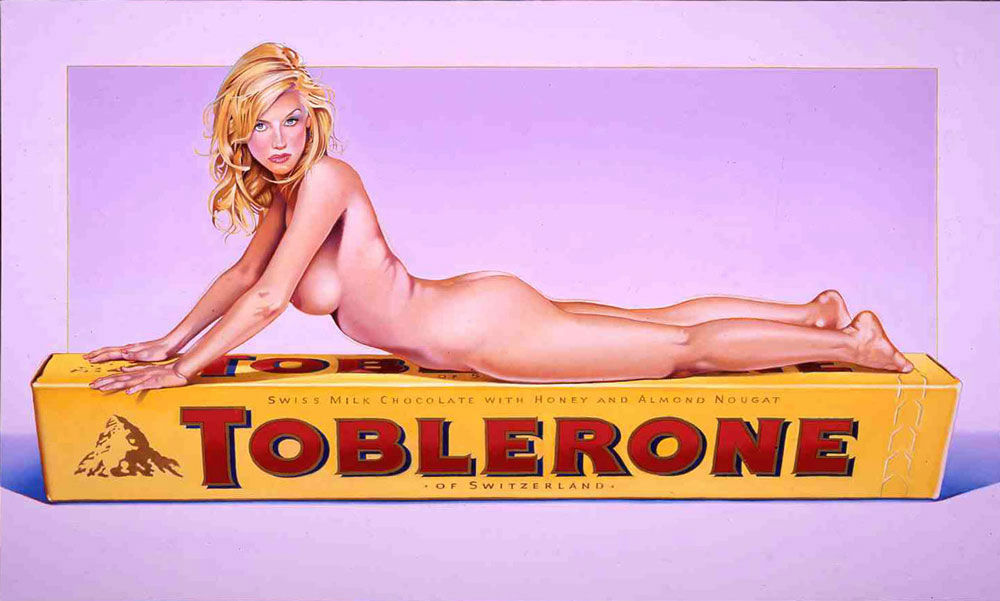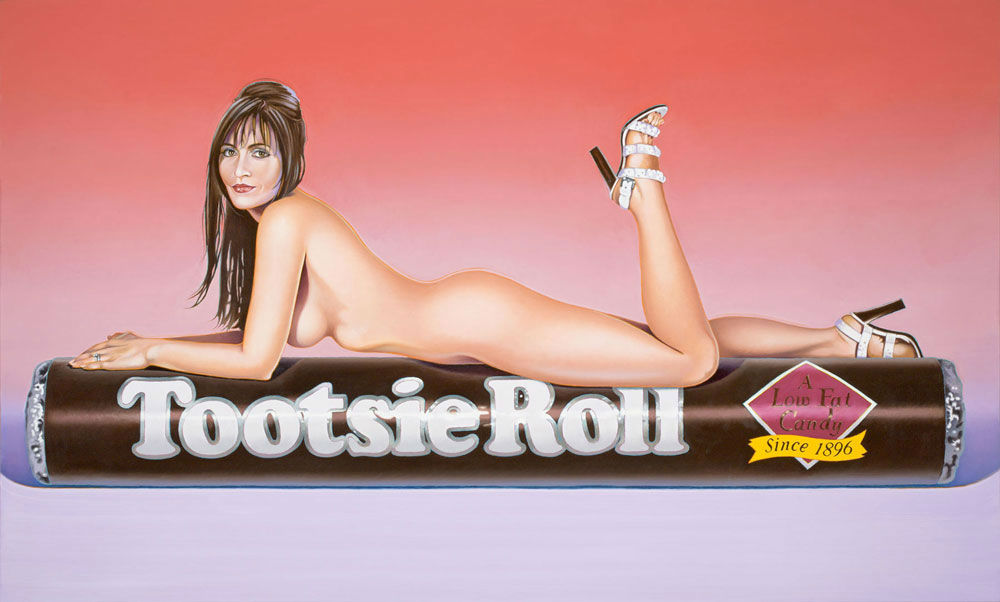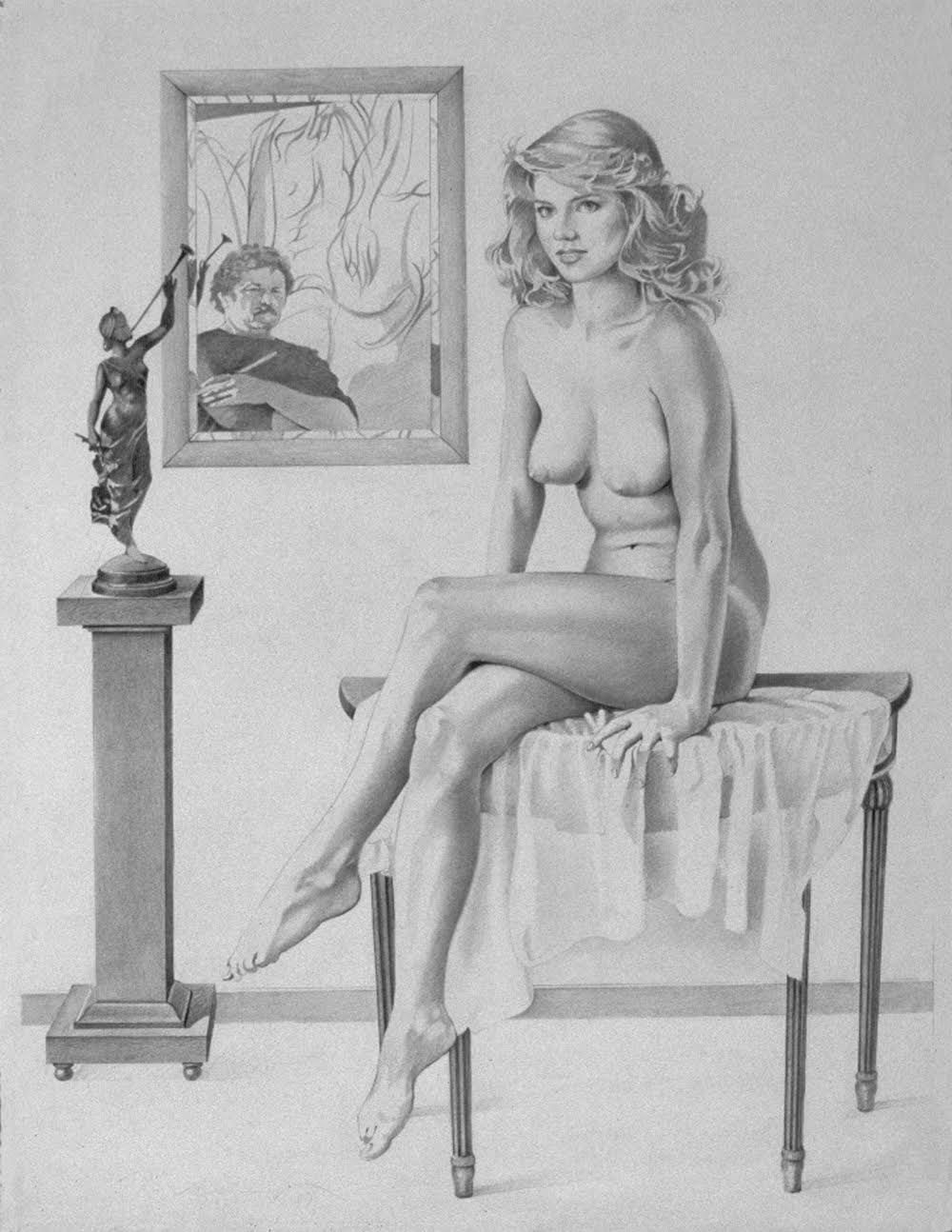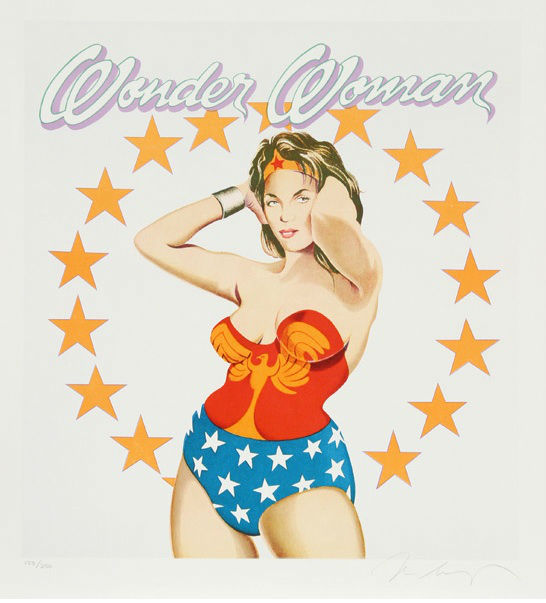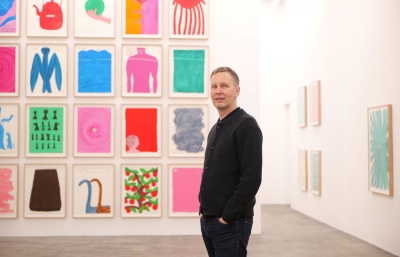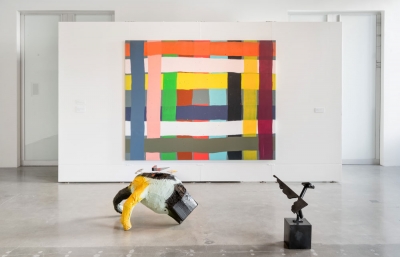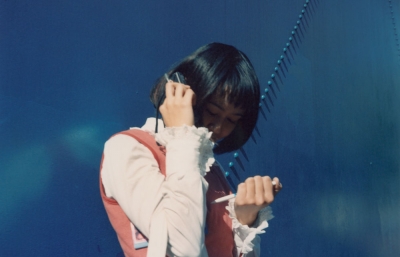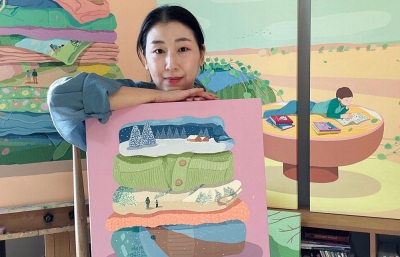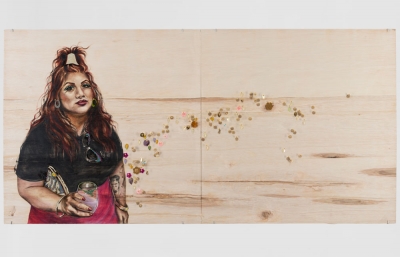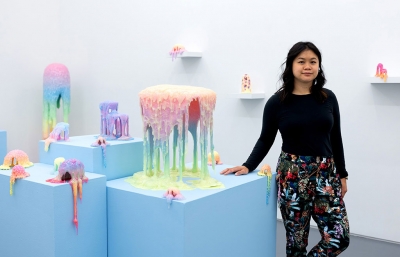Aiming to delve into line and composition, I asked Mel Ramos what came first, the martini glass or the girl. “Hell, I don’t know,” he shrugged expansively, “I just painted them, and they looked so gorgeous together! All of a sudden, a rash of husbands want me to paint their wives!”
In anticipation of his Power of Pop show at the Gregorio Escalante Gallery, I paid a visit and learned that this is a man who admits to, “being content coming to work every day and having a lot of fun.” This is a man still married to his wife and muse Leta for over 60 years, who counts Wayne Thiebaud as a mentor and life-long friend, and whose daughter/manager Rochelle greets me at the front door of his Oakland Hills home. Homespun holiday décor interlaces collections of toys, stacks of magazines and Leta’s high-heeled shoes, not to mention Mel’s superhero paintings and a brunette-straddling-cigar sculpture, fabricated in France, cresting the living room couch.
Ramos revels in the roll of the dice and marvels at the relativity. Art history became a real practice as he honed a technique for the figurative with Thiebaud, emulated the bold intensity of de Kooning, delighted in Dalí’s (in)congruities and embraced the mythology of comics. Animal, vegetable or mineral, it’s all, as he has said, “part of the visual landscape,” peppered with a Surrealist sensibility. He recalls a woman who asked to sit for a portrait, but was disappointed that he had given her two chins. To which he replied, “I didn’t know you wanted me to paint three.”
Read this feature and more in the March 2017 issue of Juxtapoz Magazine.
Gwynned Vitello: In researching a recent piece on Frank Stella’s retrospective, I smiled at his unvarnished comment that, “My painting is always based on the fact that only what can be seen is there.” You seem to be matter-of-fact in the same way, and the joy in viewing your work is very immediate and of-the-moment.
Mel Ramos: Somebody along the way, I can’t remember who, used that line about my work, “What you see is what you get.” I had the distinction of being older than Frank by a year. You know, he’s a very good tennis player. We hang out in different regions in New York, though.

Did you ever live in New York?
Did I live there? It depends on how long you have to be in New York to qualify living there. I stayed there for months, or one time for six weeks, when doing a piece at Marlo Graphics. I love New York, but somebody has to hold up the West Coast! We don’t have the population like they do out there. I have great affection for the West Coast. I was watering the lawn last spring, and somebody stopped and asked, you know, “How’s it going?” I’m the oldest person on this street. I’m the czar. Rochelle was four when we moved here.
You’re the czar, but Rochelle is your manager.
Rochelle is my studio manager, and she’s turned my life around drastically. I don’t have to listen to what people tell me to do, I don’t have to do any of that stuff anymore. She’s expensive, but not too expensive! Believe it or not, she used to be a restaurateur for ten years or so. She had a restaurant in Danville, California, Pacific Pasta. She made her own pasta every day. That was a lot of work, waking up at five o’clock in the morning. So I’m busy and Rochelle has a great gig.
I like to participate in the local stuff. I’m in the middle of organizing a foundation for my wife and myself. Rochelle is handling it, talking to the lawyers and accountants, all that kind of stuff. We’re dealing with artists at the Center for Creative Growth in downtown Oakland. Every day, clients, people with developmental disabilities like autism and Down’s Syndrome, go there to participate in art projects. I like to go there for a period of time and be involved, say, have the artists do a calendar. The clients, who are also the students, create and sell it at their bookstore. There’s a physical building, and one half is where they paint, crochet, do artsy stuff, and the other side is where they have the front office and hold exhibitions.
How did your show at Gregorio Escalante Gallery in Los Angeles come about?
It’s with my first studio manager, Gabe, who’s involved in the La Raza movement.

Speaking of Southern California reminds me of another guy holding up the West Coast, Ed Ruscha, who shares your humor and wordplay.
Eddie and I are pals. I have his work. He has my work. But he’s a big movie star (and his wife was a movie star). We have a gallery director in Palm Springs that we both work with, Imago Gallery. Eddie and I were showing there at the same time. I’ve known him for a long time.
Wordplay? Yeah, I was doing some painting for an art history series long ago. I invented phrases like, “You Get More Spaghetti with Giacometti.” And another one, “You Get More Salami with Modigliani.” That came about because I walked into a decked-out deli and saw this reddish salami. It was a gorgeous red color, and I walked in and bought five pounds. I had heartburn for a month; when you get one or two of them, that’s all you need.
Ha! Your art classes must have been very popular.
I was always drawing. I started off in high school doing the mascots and posters for the football team. I get asked by young kids for advice, and it’s kind of boring, but I always give the same advice: “Follow your bliss.” What happened was, I fell in love with Leta, and I kind of chased her down to San Jose where she was going to school. I was playing the classical guitar and taking lessons. She told me, “Look, get with it, will ya! You’re either gonna be a guitar player or a painter, you can’t do them both.” I have two guitars now, and I never play them anymore, but I have some great CDs and could listen to them forever.
You always make a point of fondly crediting Wayne Thiebaud as your mentor at Sacramento Junior College. I’ll bet you also enjoyed teaching.
It was painting and drawing. If it’s painting, it’s the principles. We’ll talk about oil paint and acrylic, which dries faster, and you get lot of different results. But it’s hard to do. I like to teach art. Though I’m not very good at showing them how I do my own art, I like to show the students whose work I can steal from and show them how to do it. Like little still lifes I can do in a couple hours, but Roy’s [Lichtenstein] will take three days.
I was 65 when I retired in 1994. It felt like, bang, bang, I don’t have to go to class! What am I going to do with my day? It took me about a year to get over that. So then I went to a lot of museums, looked at a lot of books, decided to do a drawing show. When I stopped using oil paint because of a skin condition, I did a couple books on watercolors.
What’s your routine these days?
What I do now is I get up, check my email in the morning, make a cup of coffee, then I go down and see what needs to be done for that day, ’cause when I finish the day before, my eyes are in a stupor. I can’t tell what I did, so when I come back in the morning, it’s very sharp and clear. That goes on every day of my life. On Sundays, I try and stay awake for the Warriors, my favorite team, and also for the Oakland Raiders, who are my favorite football team. I became a great Raiders fan when I came here in 1967. But when they left for a time and went to LA, every day I pissed on their grave. Every Sunday morning I waited for the Raiders and they didn’t show up.
But they’re back! You’re busy and you seem pretty satisfied.
Well, in 1956 I went to New York with a group of art students from Sacramento, and we’d go to the Cedar, and you’d see de Kooning, Franz Kline, Jackson Pollock, all gassed up at the bar. It was impossible to get past them; they were front line stuff. De Kooning, how could you eclipse his work? Turns out, 50 years later, our roles could be reversed. I get a lot of mail from people asking for autographs, get them three or four times a week, some come with addresses and want a freebie, so you just have to give it to them. Yesterday a guy wrote six times under different names—but the writing was identical! Coming up from Sacramento, and now my marketplace is the world.
How did you end up buying your home in Spain?
One year in Zurich, I’d just had a show at Bruno Bischofberger, and the gallerist said he couldn’t sell my work anymore, “but here’s a guy who buys it all, why don’t you collect the money from him directly.” Turns out I met a guy named Sandro Bocola, I can never forget him. He said, “We’re going to Barcelona tomorrow to look for houses to buy. If you don’t have anything to do, come with us.” I didn’t have anything to do, so I said, “Okay.” We took the 90-minute flight, rented a car and drove to a town called Boca de San Juan, met a short, stubby guy named Zeppo, a farmer, and he showed us about 30 houses all around the various villages. Sandro bought two houses, and I bought one. What the hell, I had sold some work in Zurich and had a few grand in my cowboy boot. The house became mine, 40 minutes from the Spanish Riviera. It didn’t have a studio and I did watercolors on the kitchen table. There’s a big town nearby that sells art supplies and we’ve been going there every summer for 45 years.
Since Salvador Dalí is credited as your biggest influence, did you ever get a chance to meet him in Spain?
My house is about a four-hour drive from his, and one day we were driving around and went to his show at the museum. They told us that we might be able to visit him at his house, so we called and he answered the phone, and very quickly said, “Come on over tonight!” So we bought some flowers. His maid let us in and we sat on the terrace waiting with about ten other people for him to enter. He came out in a white toga and gilt cane and sat down next to me. He calls each person to come over, and finally calls me. I gave him a catalog from the Oakland Museum, and he looked at my de Kooning painting of a girl and said, “You painted abstract impressionism? I answered I had, and he said, “Why didn’t you commit suicide?”
----
Originally published in the March 2017 issue of Juxtapoz Magazine, on newsstands worldwide and in our web store.

